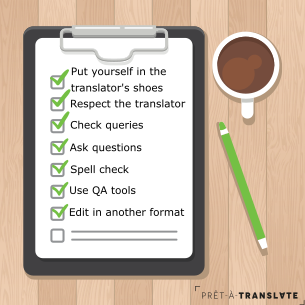
The incomplete ten commandments of editing
Will you help me finish them?
Four eyes are better than two. It may be an idiomatic expression, but boy is it true!
Although it’s a stage during the translation process that many clients try to minimise or even cut out all together to save money, editing is a must for any translation project.
We all make mistakes. We are human after all! When you’re working on the same translation for a long time, it’s easy to make silly mistakes.
That’s why it’s a good idea to get an editor to look over our translations. It’s a win-win situation for everyone: for us translators because we learn from editors’ feedback and improve our work and for clients because they receive a quality product. As in other phases of the translation process, cutting out the editing stage is risky for all of us.
After 17 years in the translation business, I’ve been edited (and am still edited) by all sorts of translators. There’s those that want to leave their mark on your translation and others that suggest changes that really do improve your work.
An editor isn’t born an editor per se, they become one, and that’s why I decided to create these ten commandments of editing. I hope you find them useful whether you are a freelance translator, you work in a translation agency or in the translation department within a company. Because it’s good to edit, but let’s be honest, nobody likes wasting time doing more than what’s needed.
- Put yourself in the translator’s shoes. You have to edit in the same conditions that the translator had to translate, i.e. with the same instructions and reference material provided by the client. Read all of this information before you start editing and let the client know if you have any queries or any material is missing. If not, you run the risk of adding mistakes to the translation.
- Respect the translator. As we all know, there’s more than one way to skin a cat: every translator has their own style, so don’t go changing things that aren’t completely necessary. If you change something because you prefer it that way, highlight that it’s your preference and not a mistake. Some companies count editors’ changes to give translators a mark for their work and it’s not fair on the translator if your changes are preferences as it would affect their score.
- Check if the translator had any queries. It’s common for the project to pass to the edition stage without the client having answered the translator’s queries. Normally, the editor is the last person to be in contact with the files, so it’s their job to check if there are any pending queries and apply any necessary changes.
- Ask the translator and the client questions. You may have questions that the translator didn’t come up with or you may want to ask the translator why they have used a certain term over another. There’s not always time for this, but if you have a question about the translation, ask your project manager, who will forward it to the translator or you could even ask to be put into contact with the translator. Communication is essential for any project to be successful.
- Spell check. It doesn’t matter if the translator already ran the spell checker. You may have added a spelling mistake to the document without realising.
- Use quality assurance tools. As with the spell checker, use QA tools at the end of each stage (and even several times) to minimise any mistakes. These tools often give many false positives, so you need to adjust the settings to filter any errors that aren’t really mistakes.
- Print the translation on paper or edit it in another format. I must admit that I don’t do this as often as I used to, but editing on paper lets you pick out some mistakes that could go unspotted in any other format, such as double spaces, typos or spelling mistakes. If you can’t print it, at least edit it in a different format. For example, instead of editing the text on the bilingual screen of a translation tool, export it to Word.

As you can see, the ten commandments are incomplete.
What else would you include? I’m sure we can together think of more than ten tips. Add your ideas in the comments.
See you for the next post!
